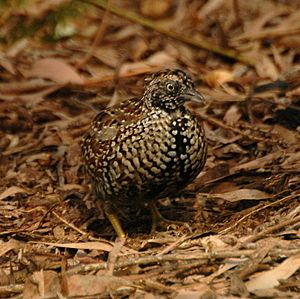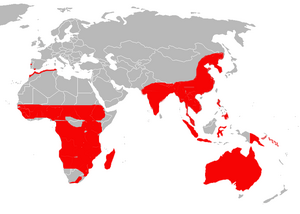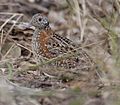Buttonquail facts for kids
Quick facts for kids Buttonquail |
|
|---|---|
 |
|
| Black-breasted buttonquail (Turnix melanogaster) | |
| Scientific classification |
|
| Kingdom: | Animalia |
| Phylum: | Chordata |
| Class: | Aves |
| Order: | Charadriiformes |
| Family: | Turnicidae GR Gray, 1840 |
| Genera | |
|
Turnix |
|
 |
|
| Distribution of the buttonquails | |
Buttonquails, also known as hemipodes, are a unique group of small birds. They belong to their own special family called Turnicidae. Even though they look a lot like regular quails, they are not closely related to them.
These birds live in warm grasslands across Asia, Africa, Europe, and Australia. There are 16 different kinds, or species, of buttonquails. Most of these species are part of a group called Turnix, while one special kind is in the Ortyxelos group.
Buttonquails are small, usually dull-colored birds that prefer to run rather than fly. Interestingly, the female buttonquails often have brighter feathers than the males. For most buttonquail species, both the male and female work together to build a nest on the ground. However, it's usually the male who sits on the eggs to keep them warm and takes care of the young birds after they hatch. The female might then go on to mate with other males. Their eggs hatch in about 12 or 13 days, and the young birds can fly within two weeks!
What are Buttonquails Like?
Buttonquails are small birds that live on the ground. The smallest species is the Quail-plover, which is only about 10 cm (3.9 in) long and weighs just 20 g (0.71 oz). Other buttonquails in the Turnix group are a bit bigger, ranging from 12 to 23 cm (4.7–9.1 in) in length and weighing between 30 to 130 g (1.1–4.6 oz).
They look a lot like true quails, but there are some key differences. For example, buttonquails do not have a back toe. They also lack a crop, which is a pouch in a bird's throat used for storing food. Female buttonquails have a special vocal organ. It's made from an enlarged windpipe and a part of their throat that can inflate. They use this to make a deep, booming call.
Different Kinds of Buttonquails
There are many interesting species within the buttonquail family. Here are some of them:
Family: Turnicidae
- Genus: Ortyxelos
- Quail-plover, Ortyxelos meiffrenii
- Genus: Turnix
- Small buttonquail, Turnix sylvaticus
- Red-backed buttonquail, Turnix maculosus
- Fynbos buttonquail, Turnix hottentottus
- Black-rumped buttonquail, Turnix nanus
- Yellow-legged buttonquail, Turnix tanki
- Spotted buttonquail, Turnix ocellatus
- Barred buttonquail, Turnix suscitator
- Madagascan buttonquail, Turnix nigricollis
- Black-breasted buttonquail, Turnix melanogaster
- Chestnut-backed buttonquail, Turnix castanotus
- Buff-breasted buttonquail, Turnix olivii
- Painted buttonquail, Turnix varius
- New Caledonian buttonquail, Turnix novaecaledoniae (possibly extinct)
- Worcester's buttonquail, Turnix worcesteri
- Sumba buttonquail, Turnix everetti
- Red-chested buttonquail, Turnix pyrrhothorax
- Little buttonquail, Turnix velox
Images for kids
-
Barred buttonquail (Turnix suscitator)
-
Small buttonquail (Turnix sylvatica)
-
Painted buttonquail (Turnix varia)
-
Red-chested buttonquail (Turnix pyrrhothorax)
See also
 In Spanish: Turnícidos para niños
In Spanish: Turnícidos para niños





